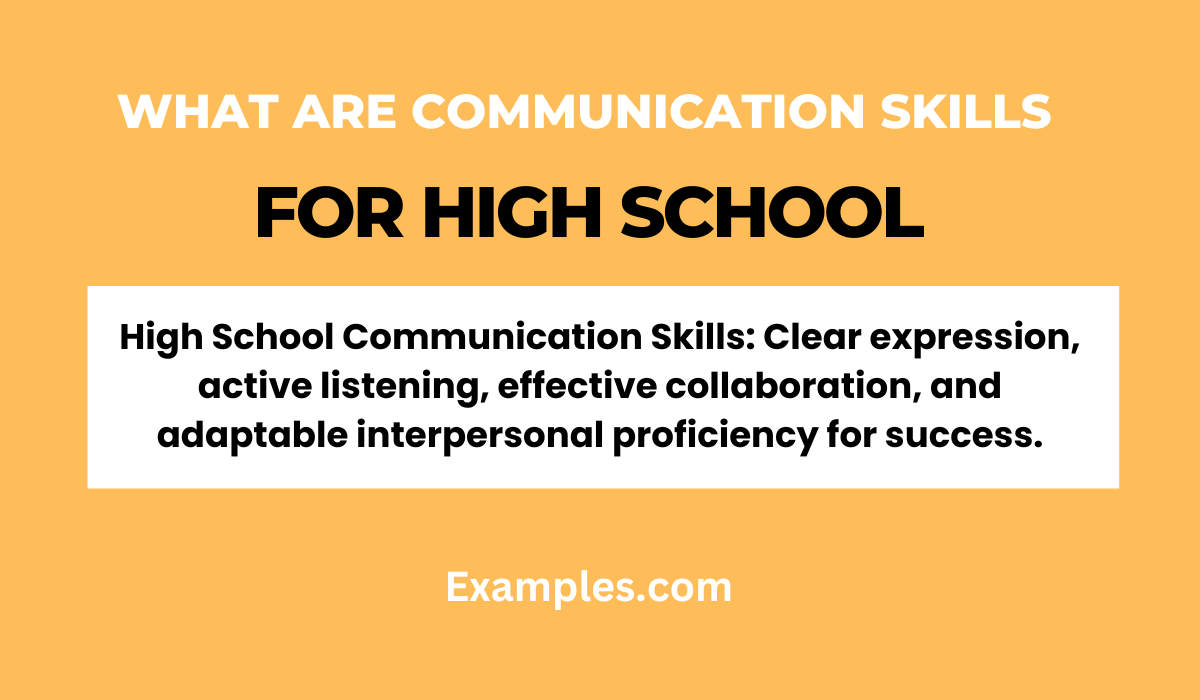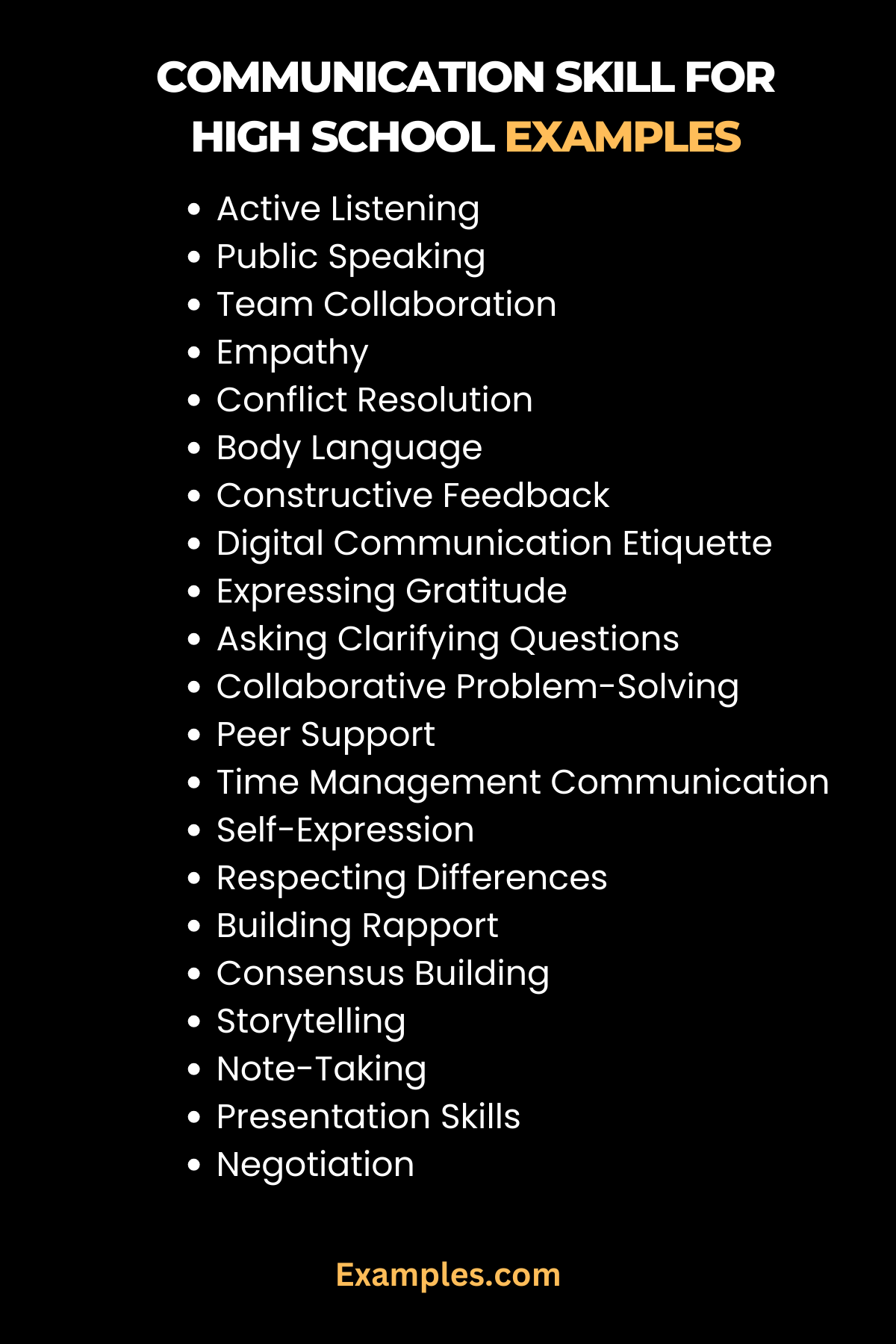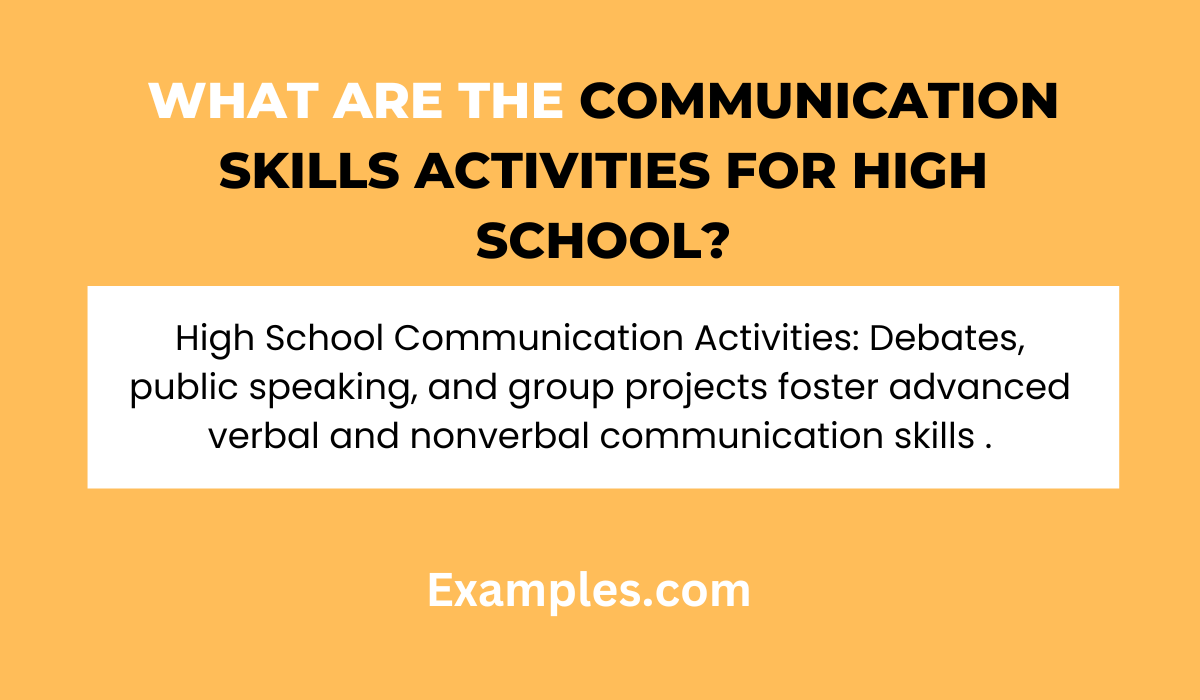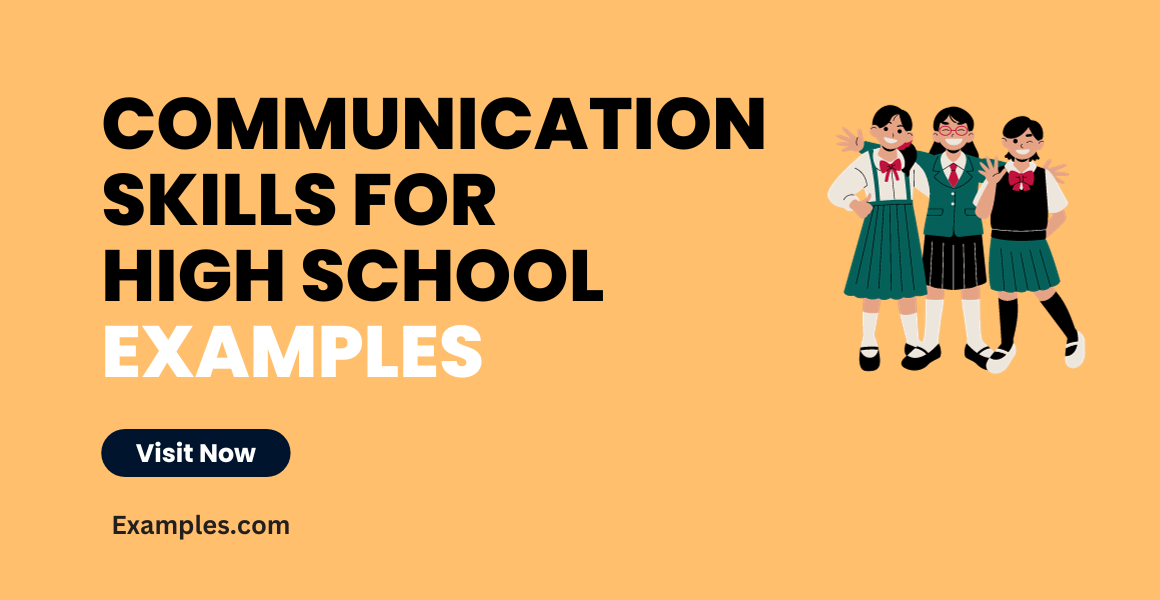29+ Communication Skills For High School Examples
Unlock the power of effective communication in high school with this comprehensive guide. Delve into practical examples, usage insights, and expert tips to empower students in mastering the art of connection and expression. Elevate their academic and social journey with a rich resource of communication examples tailored for high school success.
What are Communication Skills for High School?
Communication skills for high school encompass the ability to convey thoughts, ideas, and emotions effectively in various contexts. These skills, including verbal and written communication, interpersonal dynamics, and active listening, are essential for academic success and personal development. Mastering communication examples ensures students can navigate diverse situations with clarity and confidence.

30 Communication Skills for High School Examples
Empower high school students with 30 dynamic communication skills examples to navigate academic and social challenges. This resource provides actionable insights, reinforcing the importance of effective communication in various contexts, preparing students for success in and beyond the classroom.

- Active Listening: Cultivate understanding by paraphrasing and asking questions.
Example: “In class discussions, practice active listening by responding with, ‘So, if I understand correctly…’.” - Public Speaking: Boost confidence through clear articulation and maintaining eye contact.
Example: “Presenting a research project allows students to showcase their public speaking skills.” - Team Collaboration: Foster teamwork through effective communication and shared goal emphasis.
Example: “In group projects, ensure everyone’s input is considered by saying, ‘Let’s work together to achieve our common goal.'” - Empathy: Understand others’ feelings by expressing compassion. Example: “During conflicts, empathize by saying, ‘I can imagine that must be tough for you.'”
- Conflict Resolution: Address conflicts calmly, finding solutions together.
Example: “Resolve conflicts by initiating, ‘Let’s talk about this and find a solution together.'” - Body Language: Convey messages through positive body language.
Example: “Maintain open body language to appear approachable and engaged during conversations.” - Constructive Feedback: Foster growth through positive critique.
Example: “Provide feedback by saying, ‘I appreciate your effort, and here’s a suggestion for improvement.'” - Digital Communication Etiquette: Promote courteous online communication.
Example: “Emphasize the importance of respectful digital communication in online interactions.” - Expressing Gratitude: Acknowledge and thank others sincerely.
Example: “Express gratitude with phrases like, ‘Thank you for your help; I appreciate it.'” - Asking Clarifying Questions: Seek clarity to avoid misunderstandings.
Example: “Ask clarifying questions like, ‘Can you please explain that part again?'” - Collaborative Problem-Solving: Work together to find creative solutions.
Example: “Encourage group problem-solving by brainstorming ideas collaboratively.” - Peer Support: Offer assistance and support to classmates.
Example: “Provide help by saying, ‘I’m here to assist; let me know if you need anything.'” - Time Management Communication: Communicate needs and deadlines effectively.
Example: “In group projects, express deadlines and request help when necessary.” - Self-Expression: Convey personal thoughts and feelings.
Example: “Encourage self-expression through activities like journaling and creative writing.” - Respecting Differences: Appreciate diverse opinions and backgrounds. Example: “Discuss the importance of respecting different viewpoints, even if they differ from yours.”
- Building Rapport: Establish positive connections with peers.
Example: “Encourage finding common interests when meeting new people.” - Consensus Building: Reach agreements through mutual understanding.
Example: “Strive for consensus in group decisions by considering everyone’s input.” - Storytelling: Enhance communication through compelling storytelling.
Example: “Engage others by sharing personal experiences and narratives.” - Note-Taking: Improve understanding through effective note-taking.
Example: “Jot down key points during lectures to reinforce understanding.” - Presentation Skills: Convey information coherently and confidently.
Example: “Practice clear and structured presentations to enhance communication skills.” - Negotiation: Develop negotiation skills for win-win outcomes.
Example: “Role-play negotiation scenarios to practice constructive communication.” - Cultural Sensitivity: Foster awareness and respect for cultural differences.
Example: “Discuss cultural nuances and the importance of being culturally sensitive.” - Mindful Communication: Practice thoughtful and intentional expression.
Example: “Encourage thinking before speaking and considering the impact of words.” - Reflection: Reflect on communication experiences for growth.
Example: “Consider successes and areas for improvement in communication.” - Adaptability: Adjust communication style to suit different situations.
Example: “Discuss the importance of adapting communication in formal and informal settings.” - Debating Skills: Present arguments persuasively and respectfully.
Example: “Engage in debates to practice constructing and defending viewpoints.” - Active Participation: Engage in class discussions and activities.
Example: “Participate actively by asking open-ended questions during lessons.” - Leadership Communication: Articulate visions and goals effectively.
Example: “Practice communicating visions and goals as a student leader.” - Conflict Prevention: Proactively communicate expectations and boundaries.
Example: “Prevent conflicts by communicating expectations clearly.” - Digital Citizenship: Demonstrate responsible online communication.
Example: “Discuss responsible digital citizenship in virtual interactions.”
Communication Skills for High School Students Examples
Empower high school students with diverse communication skills examples tailored for their academic and personal growth. Navigate various scenarios, from active listening in classrooms to effective team collaboration in group projects. These examples instill confidence, foster empathy, and equip students with essential tools for successful communication in the dynamic high school environment. From active listening to conflict resolution, these real-world scenarios provide practical insights to navigate the challenges of high school life with confidence and clarity.
- Public Speaking Prowess: Enhance verbal communication by participating in class presentations, fostering clear articulation and self-assurance.
- Digital Communication Etiquette: Practice responsible online communication by emphasizing proper digital etiquette in virtual interactions.
- Role-Playing Scenarios: Develop interpersonal skills through role-playing scenarios, addressing diverse communication challenges with creativity.
- Creative Writing Expression: Foster written communication by engaging in creative writing activities, encouraging self-expression through diverse genres.
- Peer Collaboration Projects: Improve teamwork and communication by participating in collaborative projects, sharing ideas and responsibilities.
- Active Participation in Discussions: Boost confidence and critical thinking skills by actively participating in classroom discussions on various topics.
- Empathy Development Exercises: Cultivate empathy through exercises that encourage students to understand and consider different perspectives.
- Effective Debating Skills: Hone persuasive communication through participation in debates, articulating and defending viewpoints respectfully.
- Conflict Resolution Workshops: Practice calm conflict resolution by engaging in workshops focused on finding mutually beneficial solutions.
- Mindful Listening Practices: Develop mindful listening skills by actively engaging in conversations and responding thoughtfully to peers’ contributions.
Communication Skills for High School Lesson Plan Examples
Craft engaging lesson plans that integrate communication skills seamlessly into high school curricula. Explore interactive activities, role-playing exercises, and collaborative projects designed to enhance verbal, written, and interpersonal communication. These lesson plan examples promote an inclusive learning environment, allowing students to actively practice and refine their communication skills in the classroom setting. From interactive activities to thought-provoking discussions, these lesson plan examples offer educators creative ways to cultivate effective communication in the classroom.
- Storytelling Circles: Guide students in sharing personal experiences, enhancing narrative skills through a structured storytelling circle.
- Collaborative Blogging: Initiate a classroom blog, encouraging students to express ideas and engage in written communication collaboratively.
- Classroom Discussions: Organize regular discussions on thought-provoking topics to enhance verbal communication and critical thinking.
- Mind Mapping Workshops: Conduct workshops on visual communication, encouraging students to express ideas through mind mapping.
- Role-Playing Games: Integrate role-playing games to simulate real-life communication scenarios and develop problem-solving skills.
- Creative Writing Contests: Host contests to nurture expressive and articulate writing skills among high school students.
- Public Speaking Contests: Arrange contests to provide platforms for confident self-expression and public speaking practice.
- Interactive Presentations: Assign interactive presentations, where students use multimedia elements to convey information effectively.
- Peer Feedback Sessions: Implement sessions for constructive peer feedback, fostering communication and collaboration between students.
- Cross-Cultural Awareness Activities: Organize activities that promote cross-cultural understanding, enhancing intercultural communication skills.
Communication Skills for High School Examples at Workplace
Prepare high school students for future success in the workplace by introducing communication skills examples relevant to professional settings. From effective digital communication etiquette to collaborative problem-solving, these workplace-oriented examples bridge the gap between academic learning and real-world application. Empower students with the communication prowess needed to thrive in diverse workplace environments and effectively convey their ideas and contributions. This guide explores tailored examples that prepare students for professional success, emphasizing effective collaboration, clear expression, and adaptability in diverse workplace environments.
- Team Collaboration: Simulate workplace teamwork by assigning group projects, emphasizing effective communication for success.
- Digital Communication Etiquette: Introduce the importance of courteous online communication, preparing students for professional digital interactions.
- Effective Email Communication: Guide students in crafting clear and professional emails, emphasizing the nuances of written communication in the workplace.
- Professional Meeting Etiquette: Conduct simulated professional meetings, teaching students the etiquette and communication dynamics in a workplace setting.
- Crisis Communication Preparation: Provide scenarios to practice effective communication during workplace challenges or crisis situations.
- Adapting Communication Styles: Illustrate the importance of adapting communication styles based on the audience and context in a professional setting.
- Business Presentation Skills: Develop skills in delivering compelling business presentations, emphasizing clarity and confidence.
- Negotiation and Persuasion Techniques: Introduce negotiation and persuasion scenarios to enhance communication skills in professional contexts.
- Leadership Communication: Explore scenarios where students practice articulating visions and goals as future leaders in the workplace.
- Cross-Functional Collaboration: Simulate cross-functional collaboration, fostering effective communication between different departments within an organization.
What are Communication Skills Activities for High School Students?
Elevate high schoolers’ communication through dynamic activities. Facilitate debates, encourage public speaking, and implement collaborative projects to hone verbal and nonverbal skills. These activities cultivate effective communication, fostering academic and interpersonal success in high school and beyond.

High school is a crucial period for developing effective communication skills. Engage students with these dynamic activities tailored to enhance their verbal, written, and interpersonal abilities:
- Debates and Discussions: Encourage critical thinking and articulate expression through regular class debates and discussions on relevant topics.
- Collaborative Projects: Assign group projects to promote teamwork, effective communication, and the ability to convey ideas collectively.
- Public Speaking Opportunities: Provide platforms for public speaking, enabling students to build confidence in expressing ideas clearly.
- Role-Playing Scenarios: Introduce role-playing activities to simulate real-life communication scenarios and develop adaptability.
- Creative Writing Assignments: Foster expressive writing skills with assignments that encourage students to convey thoughts and emotions.
- Mock Interviews: Conduct mock interviews to prepare students for effective verbal communication in professional settings.
- Digital Communication Etiquette Exercises: Teach responsible online communication through activities emphasizing proper tone and language.
- Storytelling Circles: Create circles where students share personal experiences, honing narrative and listening skills.
- Interactive Presentations: Assign presentations with multimedia elements to enhance clarity and engagement in conveying information.
- Cross-Cultural Awareness Projects: Organize activities that promote understanding of different cultures, fostering intercultural communication.
How to Improve Communication Skills for High School Children?
Empower high school students to enhance their communication skills with targeted strategies and practices:
- Active Listening Practice: Encourage focused listening, asking questions to ensure comprehension, and paraphrasing for clarity.
- Public Speaking Workshops: Conduct workshops focusing on clear articulation, eye contact, and effective body language during public speaking.
- Conflict Resolution Training: Provide guidance on addressing conflicts calmly, finding solutions collaboratively, and expressing needs assertively.
- Writing Exercises for Clarity: Incorporate writing exercises that emphasize clarity, coherence, and effective conveyance of ideas in written form.
- Empathy-Building Activities: Foster empathy through activities that encourage understanding others’ perspectives and emotions.
- Digital Etiquette Education: Educate students on responsible online communication, emphasizing courteous and respectful interactions.
Tips for Effective Communication Skills for High School Students
Navigating the challenges of high school is significantly enhanced by effective communication skills. Here are some actionable tips:
- Clear Expression: Emphasize the importance of expressing thoughts and ideas clearly for better understanding.
- Active Participation: Encourage active participation in class discussions to boost confidence and engagement.
- Empathy Development: Foster empathy by encouraging students to consider and understand others’ perspectives.
- Digital Etiquette Awareness: Teach responsible digital communication, stressing the significance of online etiquette.
- Constructive Feedback: Promote a culture of giving and receiving constructive feedback to enhance communication skills.
- Crisis Communication Training: Provide guidance on communicating effectively during challenging or crisis situations.
- Adaptability in Communication: Instill the ability to adapt communication style based on the audience and context.
- Mindful Listening: Teach the art of mindful listening, emphasizing understanding and active engagement.
- Time Management Communication: Highlight the importance of communicating needs and managing time effectively.
- Celebrate Diverse Communication Styles: Embrace and celebrate diverse communication styles, fostering inclusivity and respect.
In conclusion, this comprehensive guide equips high school students with invaluable communication skills essential for academic excellence and personal growth. With practical examples spanning diverse scenarios, students learn to articulate ideas, collaborate effectively, and navigate real-world challenges. Mastering these skills ensures success in both educational pursuits and future professional endeavors, setting the stage for confident and impactful communication throughout life.



